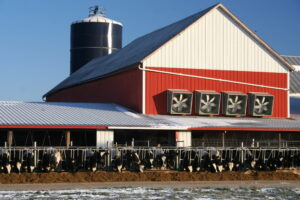As the seasons shift, ensuring optimal ventilation becomes a crucial consideration for farmers in maintaining healthy livestock during winter. Just like we bundle up on layers to stay warm, farmers also “bundle up” their cows for the cold.
“Ventilation in winter isn’t just about keeping animals warm, it’s about safeguarding their health,” says Nesli Akdeniz, Livestock Controlled Environments Extension Specialist. “Moisture accumulation, ammonia, and pathogens become key concerns.”
She says to help address these challenges, she encourages farmers to be aware of the different types of ventilation systems and what best fits their needs. From wind-dependent natural systems to mechanically controlled positive or negative pressure vents, each system aims to balance airflow and temperature.
“We aim for 4 to 6 air exchanges per hour, ensuring a healthy environment without compromising warmth,” explains Akdeniz. “We need gentle airflow that doesn’t stress the animals.”
To help achieve this, proper maintenance is key. Cleanliness is crucial; dirty vents can reduce efficiency by 30%. From keeping mechanical vents clean to ensuring moving parts in natural systems remain functional, maintenance is essential.


